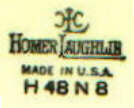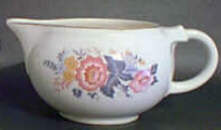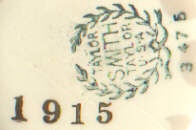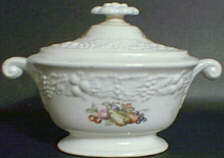Treatment vs. Shape
Dinnerware lines on this site are organized primarily by shape name and not by the treatment. In fact, any given shape could have dozens or even hundreds of treatments. Collectors are always trying to find out the names of various decals. Given the large number of treatments available, it may be next to impossible to identify all of them. The Homer Laughlin China Company alone used thousands -- and that's just one company.
When trying to identify your dinnerware, there should be three names: the maker's, the shape and the treatment. This last name is usually the most difficult since treatments were mainly named by retailers. Most potteries refered to decals, etc. with numerical designations.
The following discussion focuses on any deocorative application on dinnerware: decals, gold filagree or gold label, silk screen, hand-painted work, underglaze application, trim, and sprays.
Pottery Designations
Almost every decoration has a number which identifies the particular treatment. In Homer Laughlin's case, this number is preceded by a letter designating the original shape on which the treatment was first used. Unfortunately, the decoration number was not placed on every piece, but in most cases, it is found on the undersides of casserole lids and oval bakers.
Be aware that most of the numbers found on any backstamp are usually part of a date code indicating the month and year when the blank was made. Below are three examples which use date codes.
| Numbers indicating date not pattern identification |
 |
 |
 |
| June 1953 |
August 1948 |
March 1939 |
Here are just a few of the official decoration codes from a 1937 listing for Virginia Rose and Marigold shapes. Descriptions were given in the most general terms. Notice that VR-348 and VR-350 have the codes Y-146 and CO-100 in their descriptions. This indicates that those treatments which were used on Virginia Rose were first used on Yellowstone and COronet shapes.
 |
| Virginia Rose decoration numbers |
 |
| Marigold decoration numbers |
Though most HLC lines didn't have much more than a number signifying the decoration, many treatments used on the Swing shape had treatment names added just under the backstamp.
Similar comments may be made regarding pattern codes and Taylor Smith and Taylor's lines. On Empire, the decoration number is generally found on the bottom of the creamer in gold.
 |
 |
| Empire creamer with floral decal and its decoration number
|
Retail Names
More often than not, treatments are named by a retailer. This is where finding vintage ads becomes important. Some decals were shared by companies and the same treatment may have different name depending on the maker and retailer.
 |
The decal on this Theme sugar
by HLC was named “Surrey” by Sears
|
Names Given By Collectors
Once in a while, a treatment becomes so popular that if a retail or official name isn't known, then it is named by collectors. For example, the creamer below is HLC's Nautilus shape with the treatment number: N-260. The official (or retail) name isn't known and collectors have gotten into the habit of calling it, “Deco Leaf” or ”Deco Flower.”
When trying to find out a patten name, you must have paitence. It may be possible the pattern you have is so obscure, an official name may never be found. Dinnerware made after the mid 50s may or may not have a treatment name with the maker's mark. The backstamp below was found on a piece of Knowles and it gives a wealth of information including the maker, the shape, AND the treatment.
Sometimes you may find pieces with a double mark. This indicates that the blank was made at a pottery and decorated by some small company. Common decoration companies include Pacific, Royal China, Cunningham and Pickett. Such decorations are usually novelties and are seldom named or given numerical designations.
|